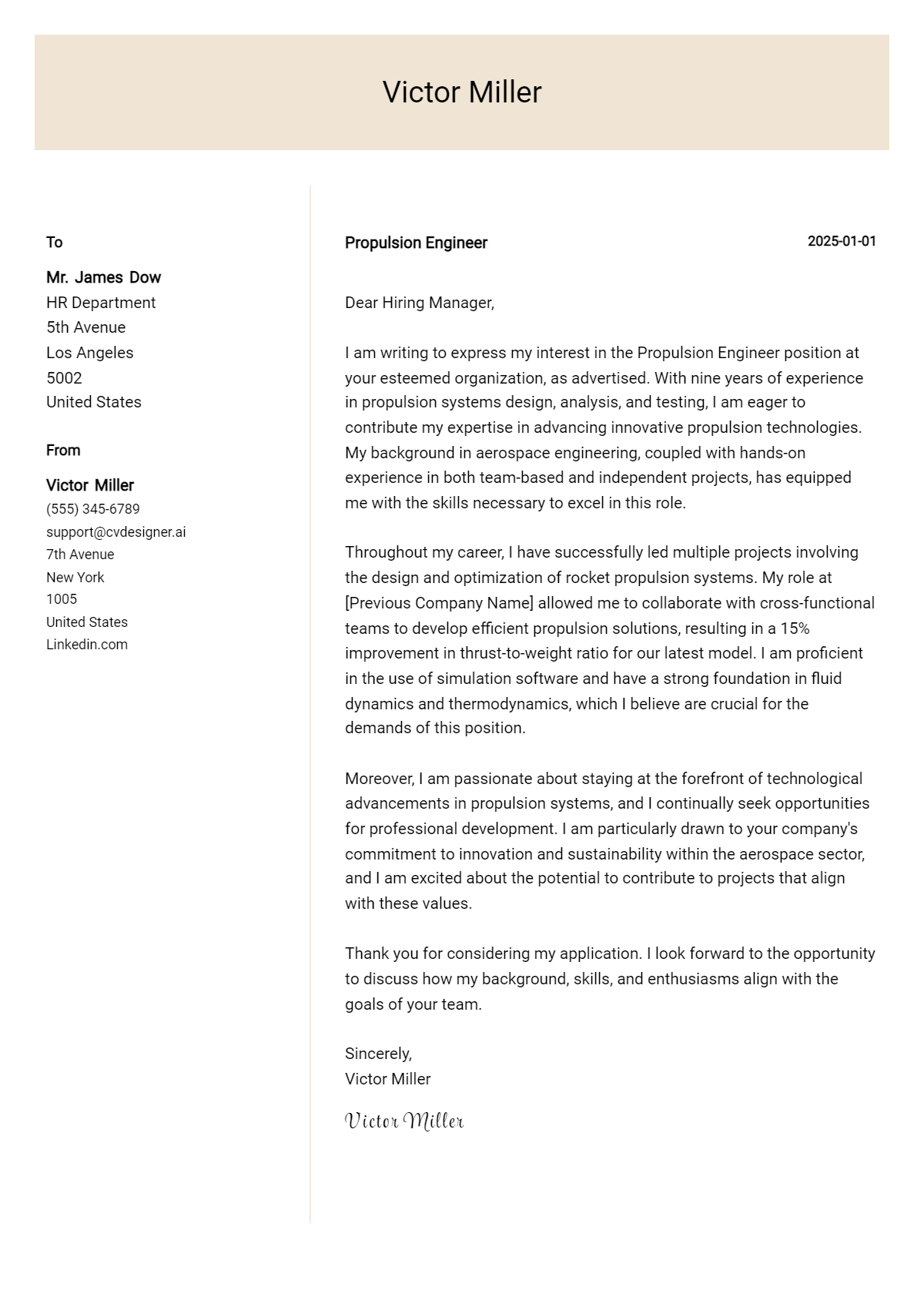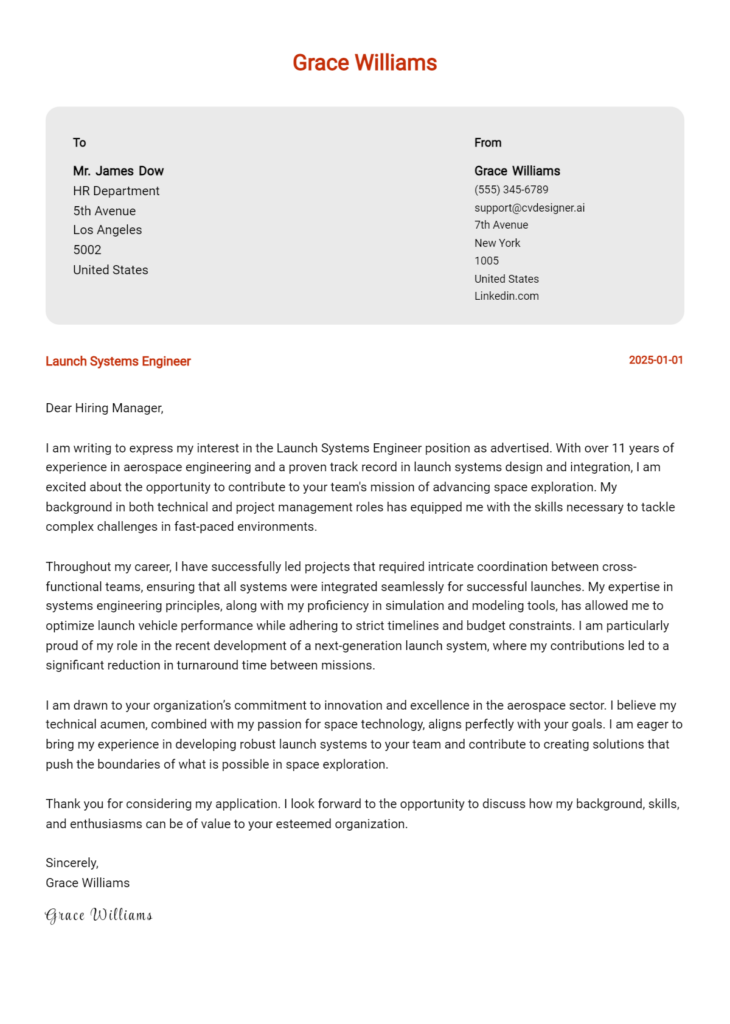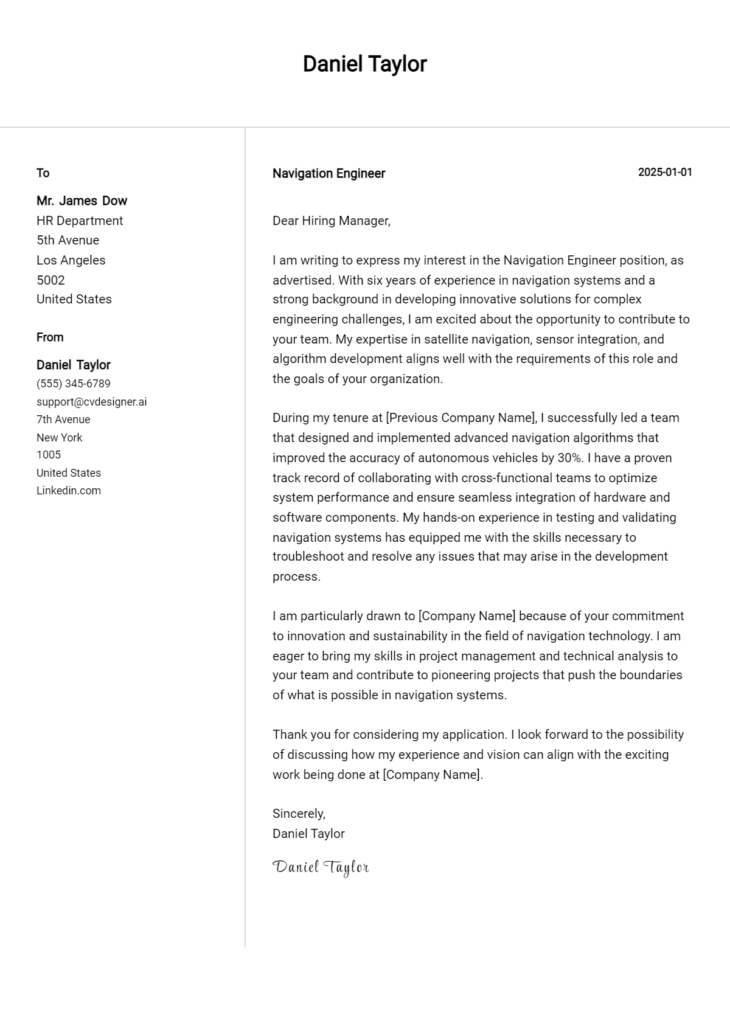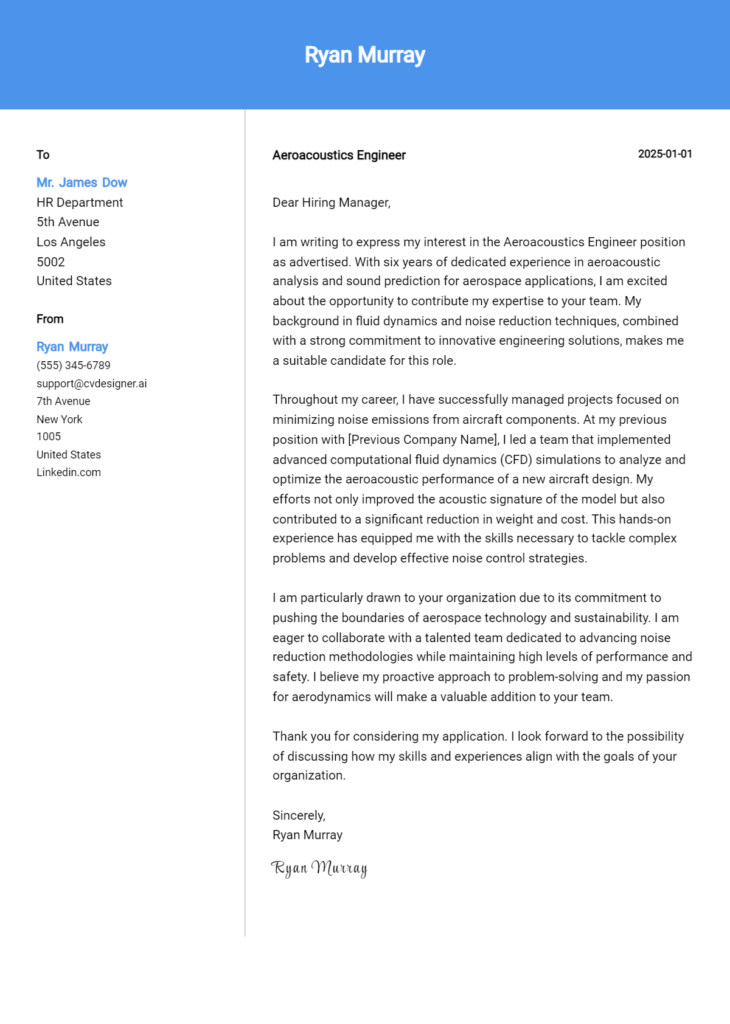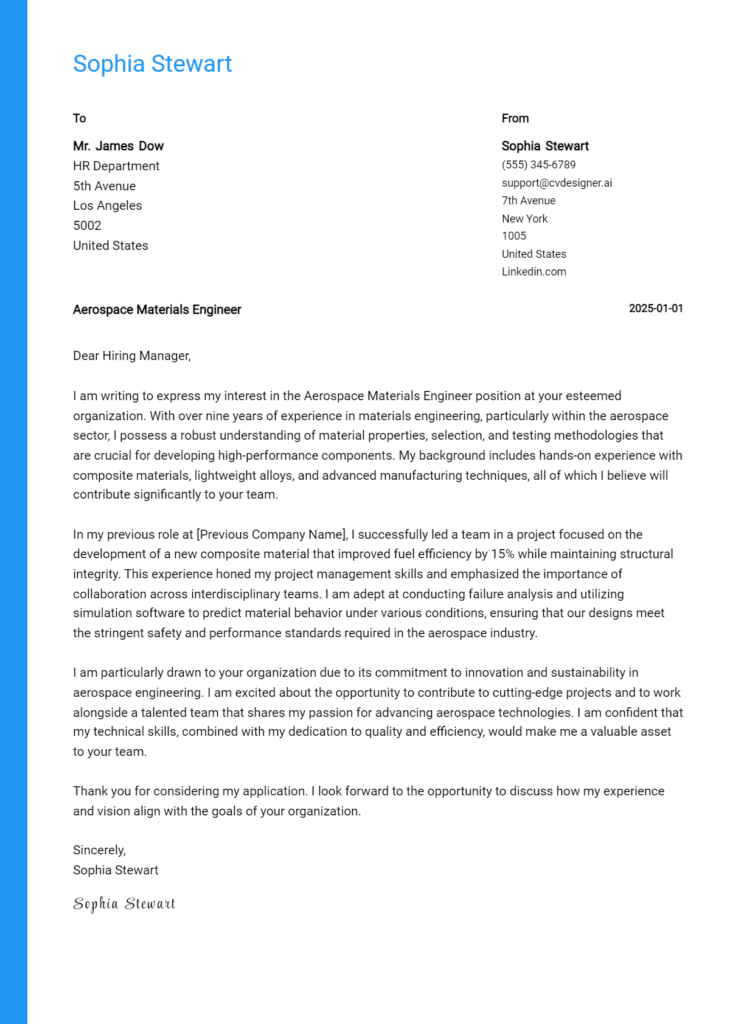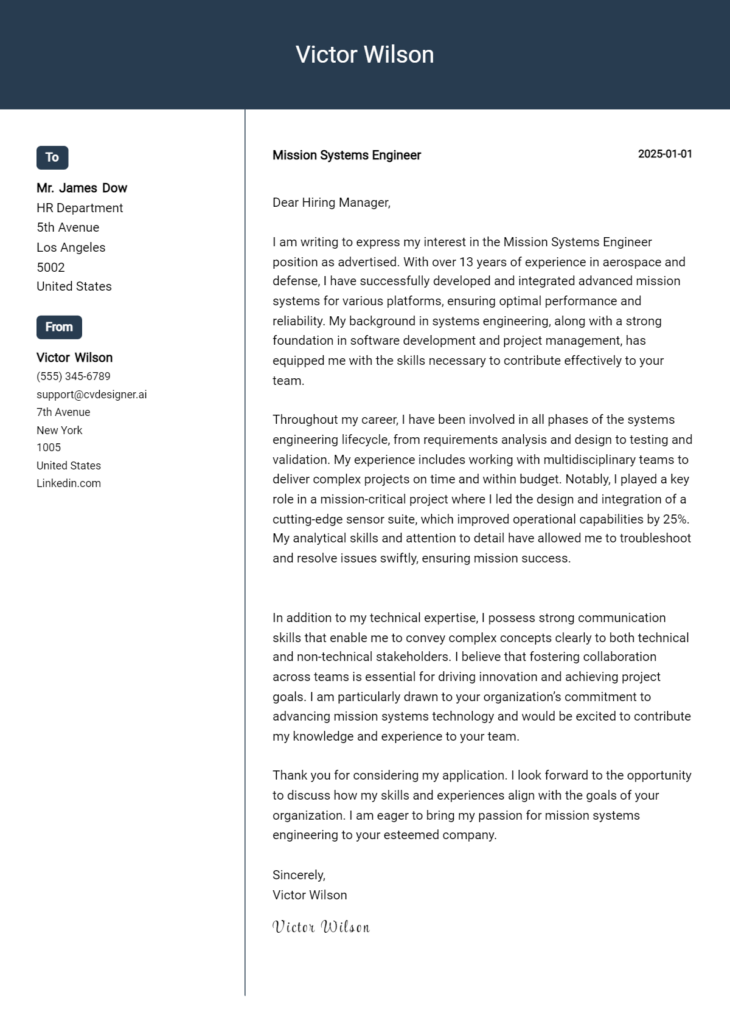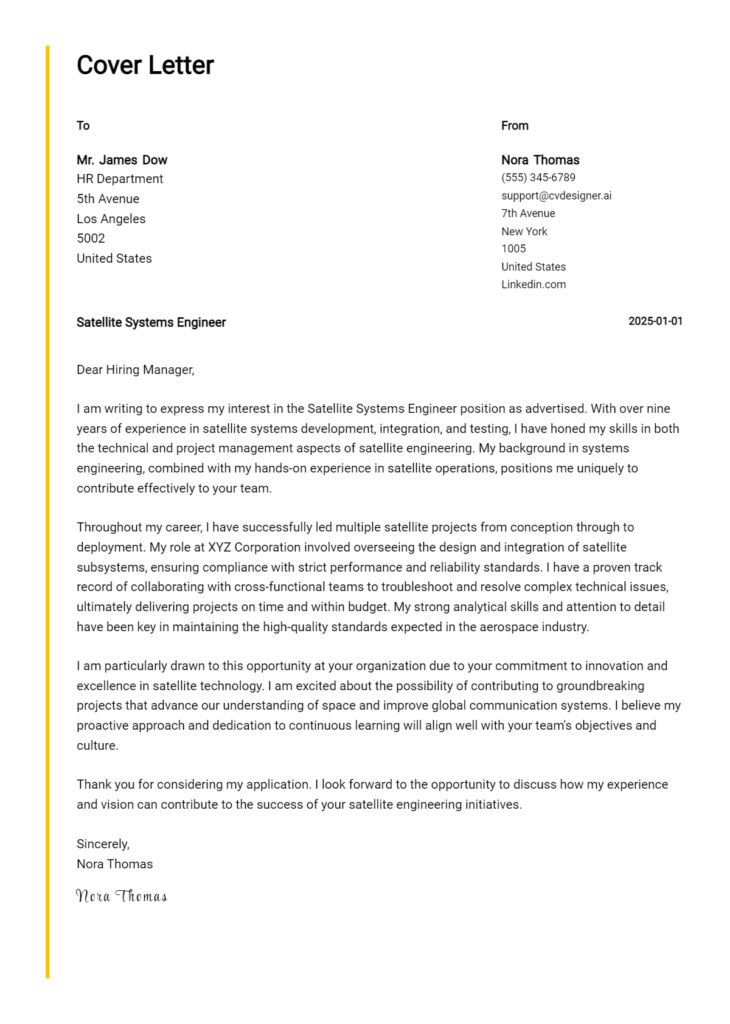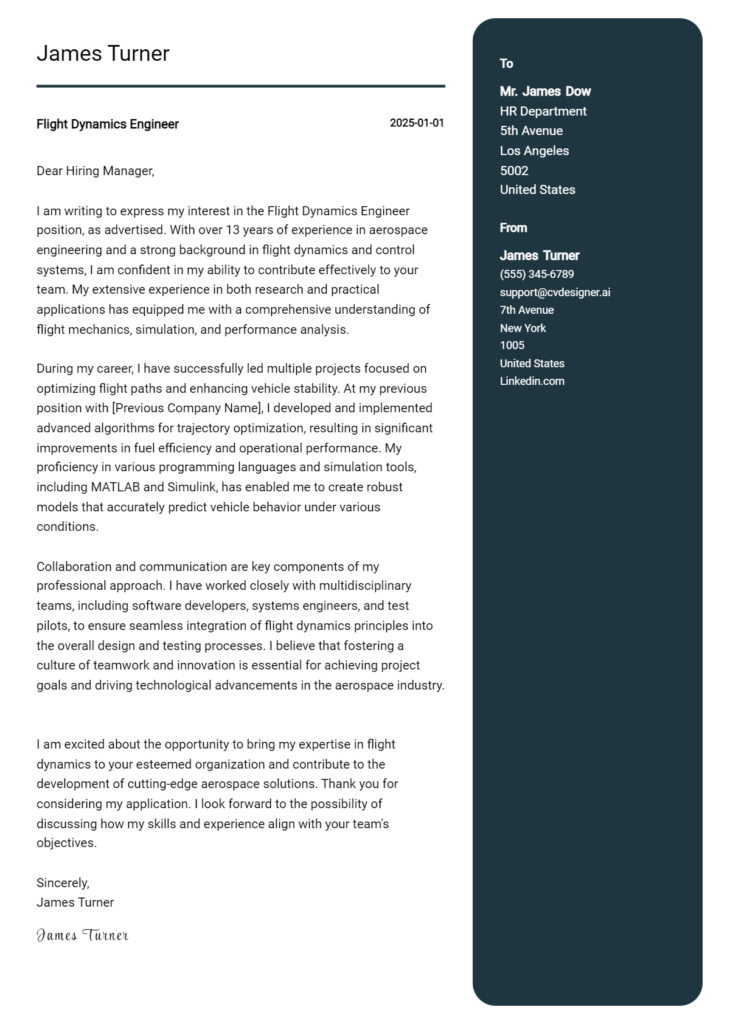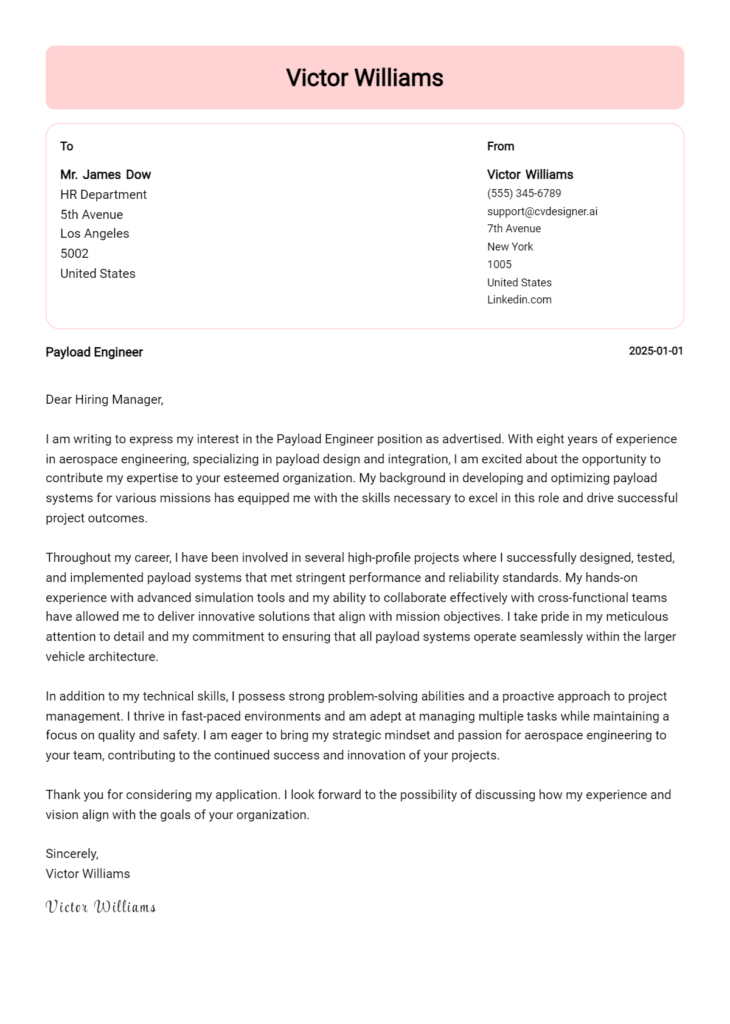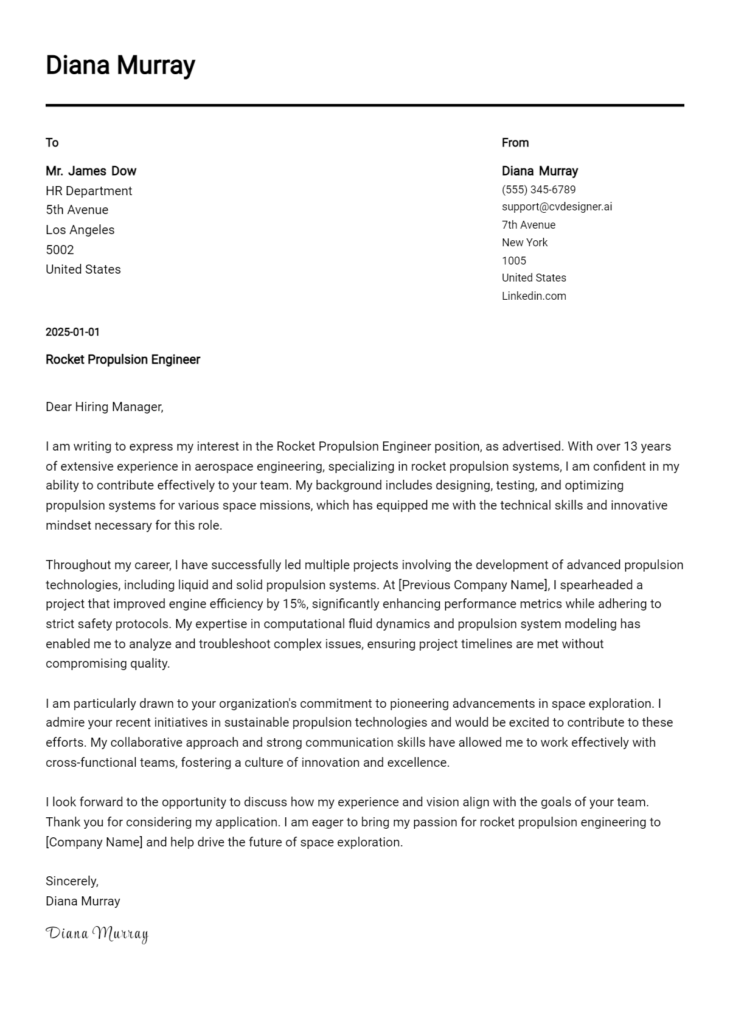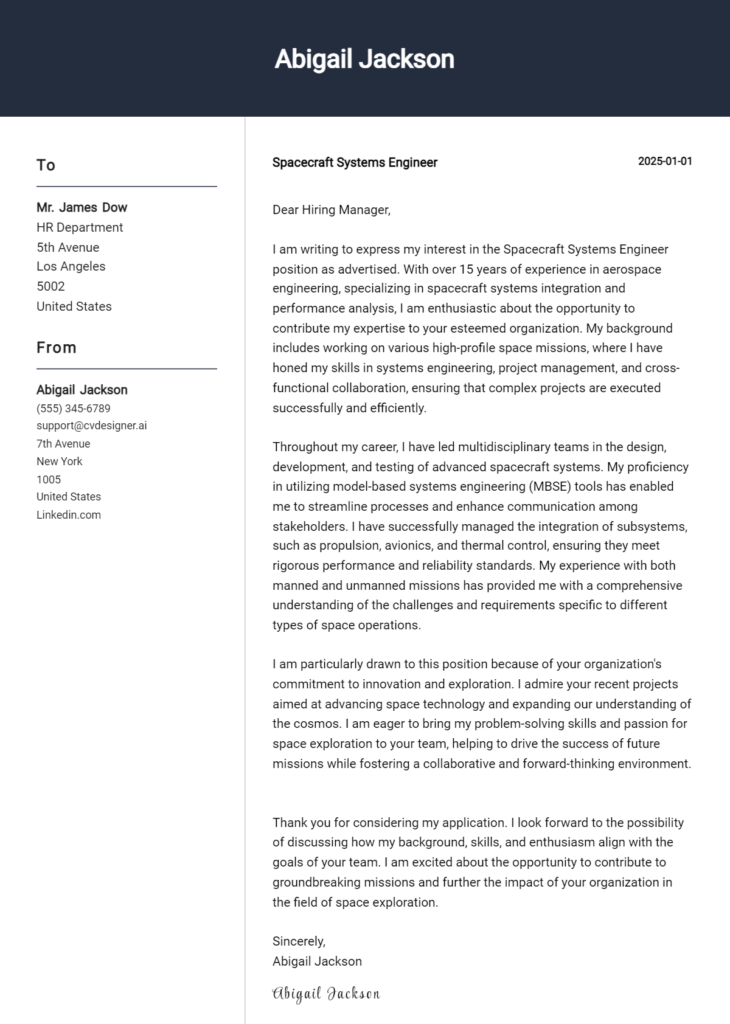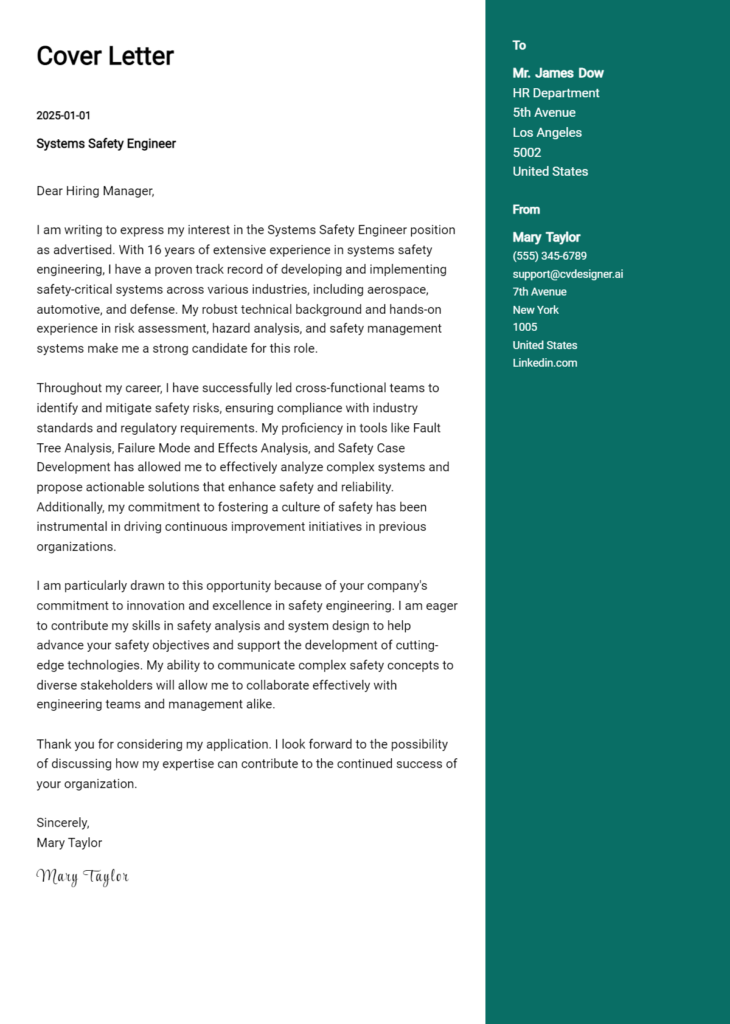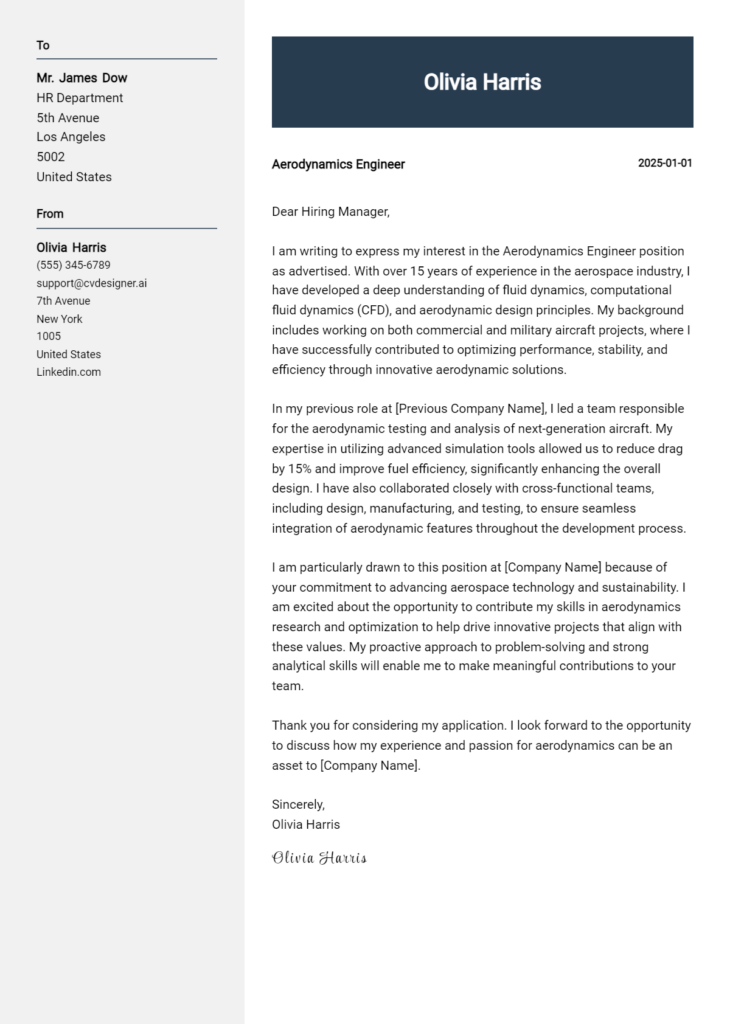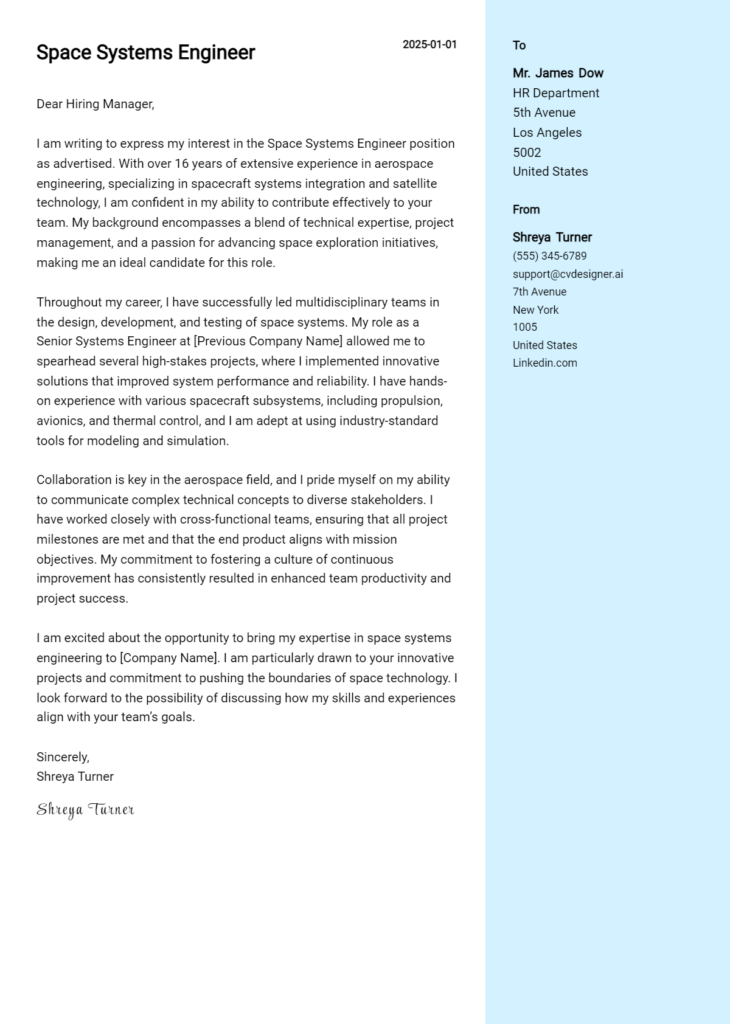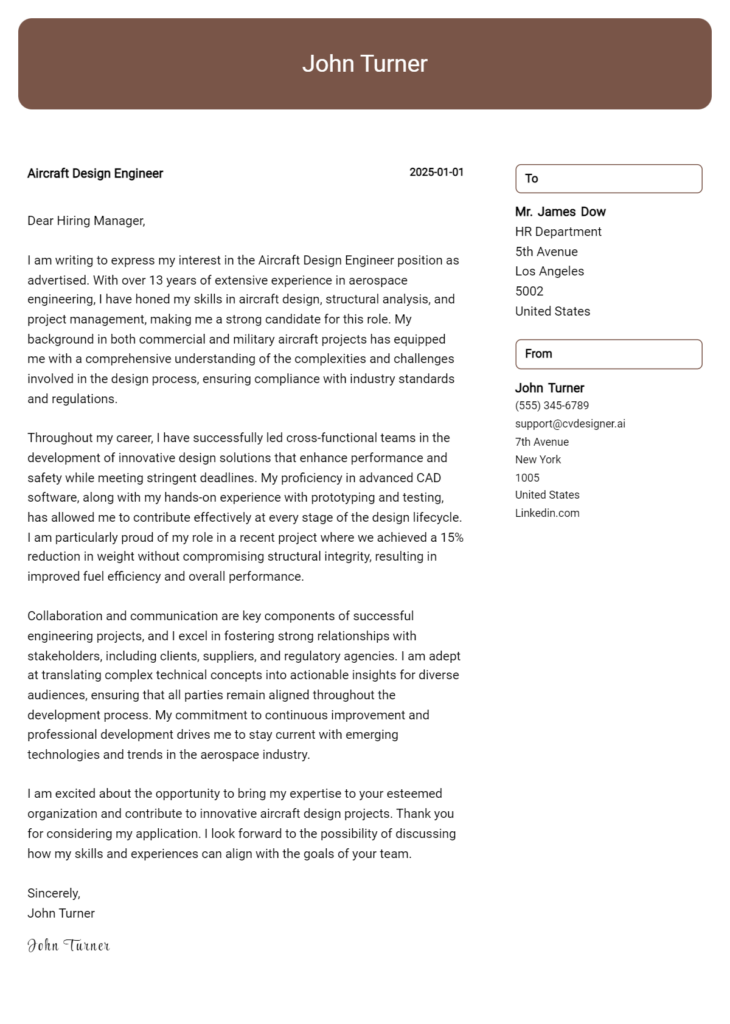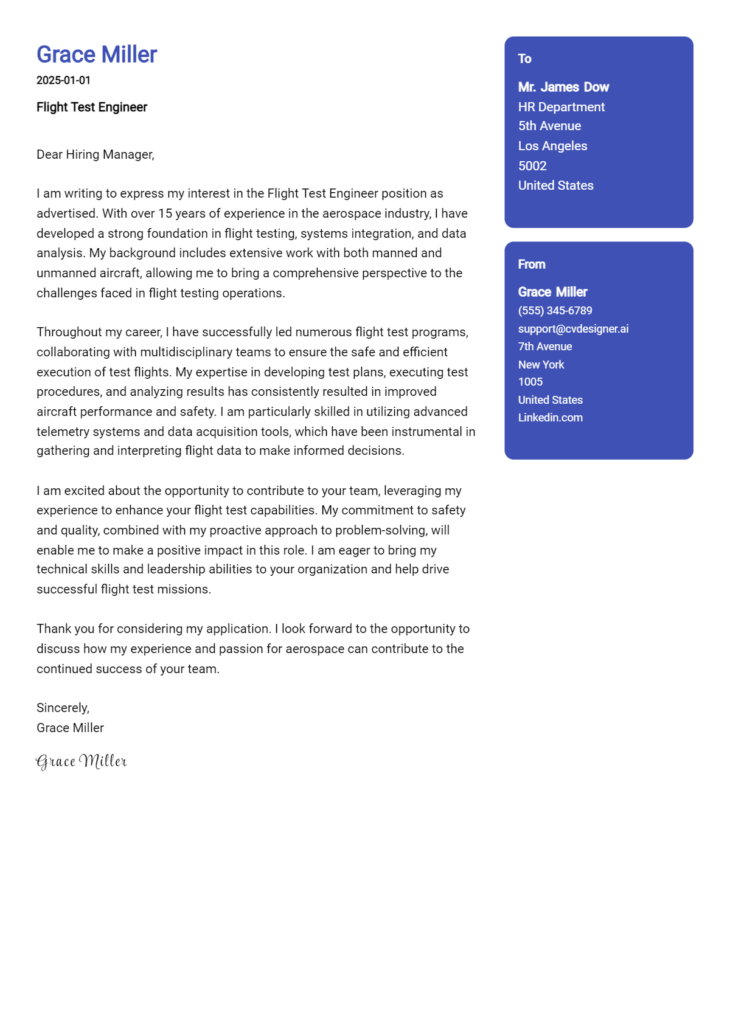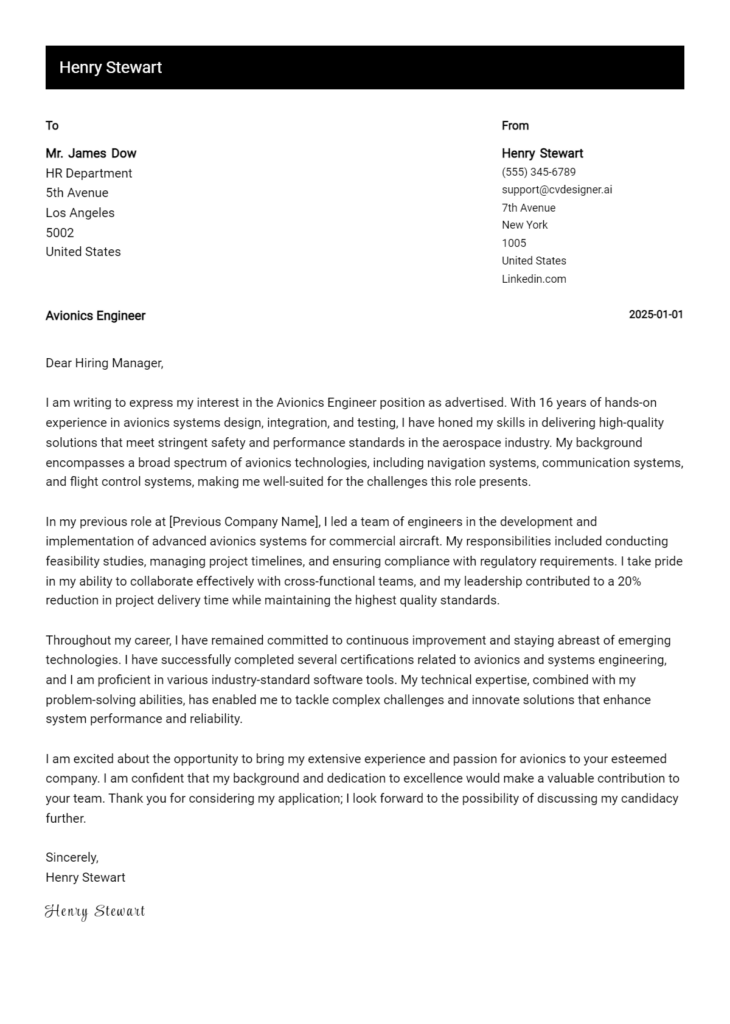Propulsion Engineer Cover Letter Examples
Explore additional Propulsion Engineer cover letter samples and guides and see what works for your level of experience or role.
How to Format a Propulsion Engineer Cover Letter?
Crafting an effective cover letter is essential for a Propulsion Engineer, as it not only showcases your technical expertise but also your ability to communicate complex ideas clearly and concisely. The format of your cover letter serves as a reflection of your engineering acumen and attention to detail—qualities that are paramount in the aerospace industry. A well-structured cover letter can capture the hiring manager's interest while highlighting your problem-solving abilities and innovative thinking.
In this guide, we will explore how to structure your cover letter, providing insights and engineering-specific examples to help you create a compelling document.
We'll focus on the essential components of a professional cover letter, including:
- Cover Letter Header
- Cover Letter Greeting
- Cover Letter Introduction
- Cover Letter Body
- Cover Letter Closing
Each section plays a crucial role in emphasizing your qualifications and professionalism. Let’s break down each part and discuss how to make your Propulsion Engineer cover letter stand out.
Importance of a Cover Letter Header for a Propulsion Engineer
The header of a cover letter is a critical element, serving as the first point of contact with a potential employer. It should clearly present essential information such as your contact details, the date, and the recipient's information, allowing for easy communication. A well-structured header conveys professionalism and attention to detail, which are crucial qualities for a Propulsion Engineer, who must often work on complex projects requiring precision and clarity. A strong header ensures that your application stands out and is taken seriously in a competitive job market.
Strong Example
John Doe 1234 Engineering Lane Aerospace City, AC 12345 (123) 456-7890 johndoe@email.com October 1, 2023 Jane Smith Hiring Manager Aerospace Innovations Inc. 5678 Tech Road Aerospace City, AC 67890
Weak Example
JD (123) 456-7890 johndoe@email.com 10/1/23 Aerospace Innovations
The Importance of the Cover Letter Greeting for a Propulsion Engineer
The greeting of your cover letter serves as the initial point of contact between you and the hiring manager, setting the tone for the rest of your application. A well-crafted greeting demonstrates professionalism and shows that you have taken the time to personalize your communication, which can make a strong impression. Addressing the hiring manager directly can establish a connection and convey your enthusiasm for the position. To avoid generic greetings, it’s beneficial to research the recipient's name, which is often available on the company’s website or through LinkedIn. A tailored greeting indicates that you are genuinely interested in the role and the organization, rather than just sending out a mass application.
Strong Greeting Example
Dear Dr. Jane Smith,
Weak Greeting Example
To Whom It May Concern,
The Importance of a Well-Crafted Cover Letter Introduction for a Propulsion Engineer
A compelling cover letter introduction is crucial for a Propulsion Engineer, as it sets the tone for the entire application. This opening paragraph should not only grab the hiring manager's attention but also convey the candidate's enthusiasm for the role. By briefly highlighting relevant skills or achievements, the introduction can create a positive first impression and entice the reader to explore the rest of the letter. Here's how to effectively craft an introduction, along with examples of strong and weak openings.
Strong Example
Dear [Hiring Manager's Name], As a dedicated propulsion engineer with over five years of experience in designing and optimizing rocket propulsion systems, I am excited to apply for the Propulsion Engineer position at [Company Name]. My recent project, where I successfully led a team to enhance fuel efficiency by 20% in our latest launch vehicle, showcases my commitment to innovation and excellence in aerospace engineering. I am eager to bring my expertise and passion for propulsion technology to your esteemed team.
Weak Example
Hello, I am writing to apply for the Propulsion Engineer job. I have worked in engineering for a while. I think I could do well in this position.
Purpose of the Cover Letter Body for a Propulsion Engineer
The body of a cover letter for a Propulsion Engineer serves as a critical platform for candidates to articulate their technical competencies, relevant experiences, and unique contributions to potential employers. It is here that candidates can delve into specific projects, highlighting their problem-solving abilities and innovative approaches to propulsion systems. By showcasing accomplishments—such as successful project completions, advancements in propulsion technology, or contributions to efficiency improvements—candidates can effectively demonstrate their value to the company and their fit for the engineering role. A well-crafted body of the cover letter not only presents qualifications but also conveys enthusiasm for the field and a commitment to driving technological advancements.
Strong Example
Dear [Hiring Manager's Name], I am excited to apply for the Propulsion Engineer position at [Company Name]. With a Master's degree in Aerospace Engineering and over five years of experience in propulsion system design, I have developed a robust skill set that aligns well with the requirements of this role. While working at [Previous Company], I led a team in the successful design and implementation of a hybrid rocket propulsion system that increased thrust efficiency by 25%. My contributions included optimizing fuel mixtures and conducting extensive testing, which resulted in a significant reduction in emissions. I am particularly proud of my role in the [Specific Project Name], where we were able to meet all project milestones ahead of schedule. I am eager to bring my expertise in propulsion technologies to [Company Name] and contribute to innovative projects that push the boundaries of aerospace engineering.
Weak Example
Dear [Hiring Manager's Name], I am writing to express my interest in the Propulsion Engineer position at [Company Name]. I have a degree in engineering and some experience in the field. I worked on a project related to rocket engines, but I don’t remember many details. I am good at working in teams, and I believe I can help your company succeed. I have a passion for propulsion engineering and would love to be a part of your team.
Importance of the Cover Letter Closing for a Propulsion Engineer
The closing paragraph of a cover letter is crucial as it serves to summarize your qualifications, reiterate your enthusiasm for the position, and prompt the hiring manager to take the next steps. A strong closing can leave a lasting impression, reinforcing your suitability for the role and encouraging the reader to review your resume or schedule an interview. Conversely, a weak closing may fail to emphasize your fit for the position or lack a clear call to action, potentially diminishing your chances of advancing in the hiring process.
Strong Example
In conclusion, my extensive background in propulsion systems design, coupled with my passion for innovative aerospace technologies, makes me a strong candidate for the Propulsion Engineer position at [Company Name]. I am eager to bring my expertise in computational fluid dynamics and system optimization to your team. I look forward to the opportunity to discuss how my skills can contribute to your projects. Thank you for considering my application; I hope to connect soon to explore this exciting opportunity further.
Weak Example
Thank you for reading my cover letter. I think I might be a good fit for the Propulsion Engineer role. Please look at my resume when you have the time. I hope to hear from you.
These tips will guide candidates in crafting an impactful cover letter for a Propulsion Engineer position, emphasizing the importance of demonstrating technical skills, problem-solving abilities, knowledge of the Software Development Life Cycle (SDLC), teamwork, and a dedication to continuous learning. A well-written cover letter not only highlights your qualifications but also reflects your passion for the field, making it a crucial component of your job application.
Cover Letter Writing Tips for Propulsion Engineer
Showcase Your Technical Skills
Clearly outline your technical expertise related to propulsion systems, such as experience with fluid dynamics, thermodynamics, and propulsion system design. Be specific about the software tools you are proficient in, like MATLAB or ANSYS, and how you have used them in previous projects. This will help potential employers understand your technical abilities and how they align with the job requirements.Highlight Problem-Solving Abilities
Propulsion engineering often involves overcoming complex challenges. Illustrate your problem-solving skills by discussing a specific project where you identified a technical issue and successfully implemented a solution. Use metrics to show the impact of your work, such as improved efficiency or reduced costs, to emphasize your critical thinking and analytical skills.Demonstrate SDLC Knowledge
If applicable, mention your experience with the Software Development Life Cycle (SDLC) and how it relates to propulsion engineering projects. Discuss your role in each phase of the SDLC, from requirements gathering to testing and deployment. This shows that you can manage projects effectively and understand the importance of integrating software with engineering practices.Emphasize Teamwork and Collaboration
Engineering projects are rarely completed in isolation. Share examples of how you have worked collaboratively within a team to achieve project goals. Highlight your communication skills and your ability to work with cross-functional teams, as this is vital in complex engineering environments where multiple disciplines converge.Express a Passion for Continuous Learning
The field of propulsion engineering is constantly evolving, and showing a commitment to continuous learning can set you apart. Mention any relevant certifications, workshops, or courses you have completed or are currently pursuing. This demonstrates your dedication to staying updated with industry trends and improving your skills, making you a valuable asset to potential employers.
For additional guidance and resources, you can explore cover letter templates and utilize a cover letter builder to help create a professional and polished cover letter.
Common Mistakes to Avoid in a Propulsion Engineer Cover Letter
Avoiding common mistakes in your cover letter is crucial for making a strong impression as a Propulsion Engineer. A well-crafted cover letter can set you apart from other candidates, while errors can lead to missed opportunities. Here are some common pitfalls to watch out for:
Generic Language: Using a one-size-fits-all approach can make your cover letter bland. Tailor your content to highlight specific skills and experiences relevant to the propulsion engineering field.
Ignoring the Job Description: Failing to align your qualifications with the job requirements can weaken your application. Always reference key responsibilities and skills mentioned in the job posting to demonstrate your fit.
Lengthy Paragraphs: Long, dense paragraphs can overwhelm the reader. Keep your paragraphs concise and focused, ensuring each one conveys a clear point.
Typos and Grammatical Errors: Errors in spelling and grammar can suggest a lack of attention to detail. Proofread your cover letter multiple times and consider using tools or asking a friend to review it.
Lack of Enthusiasm: A cover letter that lacks passion can make you seem uninterested. Use a positive tone and express your excitement about the opportunity and the company.
Failure to Showcase Achievements: Listing responsibilities without highlighting accomplishments can make your experience appear less impactful. Use quantifiable achievements to demonstrate your contributions effectively.
Not Following Proper Format: An improperly formatted cover letter can be distracting. Adhere to a professional cover letter format to ensure clarity and readability.
By avoiding these mistakes and following best practices, you can create a compelling cover letter that captures the attention of hiring managers and enhances your chances of landing an interview. For inspiration, consider reviewing cover letter examples tailored for engineering roles.
Cover Letter FAQs for Propulsion Engineer
How do I tailor my cover letter for a Propulsion Engineer position?
To tailor your cover letter for a Propulsion Engineer position, start by researching the specific company and its projects. Highlight your relevant experience, technical skills, and any specialized knowledge that aligns with their propulsion systems or technologies. Use keywords from the job description to demonstrate your fit for the role. For instance, if the job emphasizes experience with rocket propulsion or CFD simulations, explicitly mention your projects or coursework that involved these areas. Additionally, showcase your passion for aerospace and emphasize how your unique skills can contribute to the company’s goals, such as improving efficiency or innovating new propulsion technologies.
What technical skills should I highlight in my cover letter?
In your cover letter, it’s crucial to highlight technical skills that are pertinent to propulsion engineering. Focus on your proficiency in areas such as fluid dynamics, thermodynamics, and propulsion system design. Mention any experience with simulation software like ANSYS or MATLAB, as well as familiarity with propulsion test facilities and instrumentation. If you have hands-on experience with engine testing or design projects, be sure to include those details. Additionally, emphasize your understanding of propulsion technologies, including rocket engines, air-breathing engines, or electric propulsion systems, to showcase your comprehensive knowledge in the field.
Should I include my educational background in the cover letter?
Yes, including your educational background in the cover letter is essential, especially if you have a degree relevant to propulsion engineering, such as aerospace engineering or mechanical engineering. Mention your degree, the institution, and any relevant coursework or projects that demonstrate your expertise in propulsion systems. If you have completed advanced studies, such as a Master’s or Ph.D., highlight any research that pertains to propulsion technology. Additionally, if you received honors or awards during your studies, include those as they can strengthen your application and illustrate your dedication and competence in the field.
What should I avoid when writing my cover letter?
When writing your cover letter for a Propulsion Engineer position, avoid using generic templates or overly formal language that may come off as impersonal. Steer clear of repeating your resume; instead, use the cover letter to elaborate on your experiences and convey your enthusiasm for the role. Avoid including irrelevant personal information or unrelated work experiences that do not highlight your qualifications for propulsion engineering. Finally, ensure your cover letter is free of grammatical errors and typos; such mistakes can detract from your professionalism and attention to detail, which are critical traits for engineers.
Build your Cover Letter in minutes
Use an AI-powered cover letter builder and have your letter done in 5 minutes. Just select your template and our software will guide you through the process.

